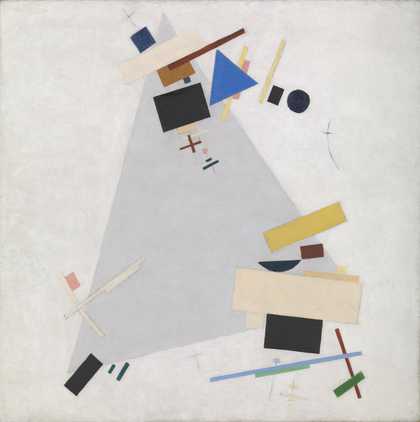The Black Square is one of the truly mythical works in early Twentieth Century art. It exerts a huge influence over the imagination of subsequent generation of artists as this Hour Zero in modern art. Until 1913 he had worked in lots of different styles.
Throughout 1915 he began to make a new set of paintings for exhibition. It was entirely abstract. And then finally he revealed his work in an exhibition and that exhibition was the last futurist exhibition, 0.10, in St Petersburg. In the original photograph you can see 20 paintings. 12 of these paintings can still be identified today. And we hung them in a way that evokes the way that they were first shown in 1915.
So yet all these paintings very colourful, all the shapes, extremely dynamic and then lo and behold the top corner of the room hung the Black Square. Some thought it was blasphemy because the top corner of the room usually is where you present Russian icons, something which Malevich was very well aware of. So, it’s almost as though it’s saying, this is the most iconic work in this exhibition and this will remain an iconic work. As a work of art it shows you how much one work can change the course of art history. The Black Square holds this incredible power.
Most of his late work has been discussed in relationship to the politics of the time and particularly the increasing clamp down of Stalin and the Bolshevik regime on avant-garde art. But they would be very hard to see these faceless figures as celebration of the peasant in the new soviet regime.
We’ve become so used to think that abstraction is an end point and that it is a symbol of progress and of modernity, that we automatically associate figuration with being regressive but I think the late work, Malevich’s late work was more complex than that. It’s not simply, it’s not repentant. He signs his latest work; his latest figurative works was the Black Square. It’s as though he wants to say, now I’m painting this but I was the inventor of the Black Square and I will not repent for this. He insists, once again, on this coexistence of different styles and different ideas about art and I think that makes him a very pertinent figure to think about from today’s point of view.

